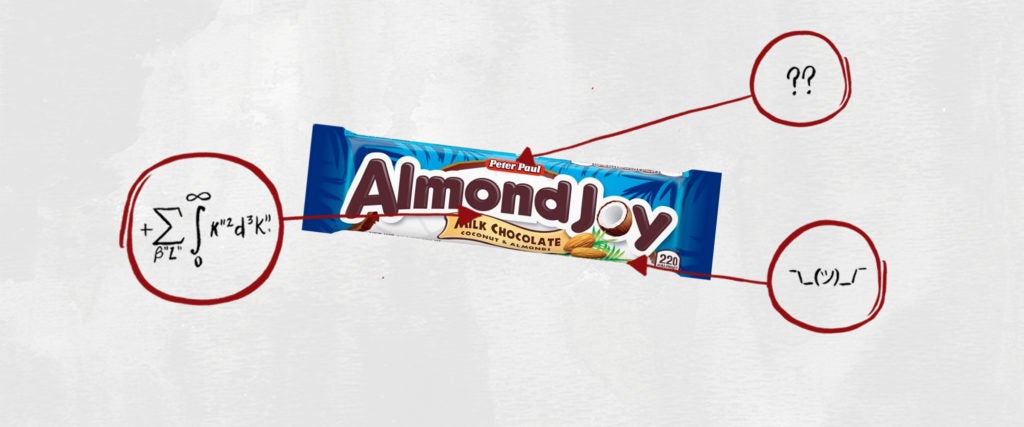We’re often told that you should never eat anything (or put anything on your body) if you don’t recognize everything on the ingredients list. But since most of us have no idea what xanthan gum or potassium benzoate are — or more importantly, what they’re doing to our bodies — we’re decoding the ingredients in the many things Americans put in (and on, or near) themselves.
This edition: Almond Joy Candy Bars, which are made from 18 separate ingredients that we’ve broken down as they appear online.
The Almond Joy Ingredients List
1) Corn Syrup: Corn syrup is a liquid sweetener made of glucose (aka sugar). It doesn’t get as much negative publicity as high-fructose corn syrup — which has been linked to obesity and diabetes by many, many studies (more on that here) — but regular corn syrup can also be debilitating, considering it’s basically liquid sugar.
2) Sugar: Speaking of sugar, a single Almond Joy contains 21 grams, which is a considerable amount. For reference, the American Heart Association recommends men consume no more than 36 grams and women consume no more than 25 grams of added sugar a day.
3) Coconut: Coconuts can be healthy, but an Almond Joy delivers hardly any vitamins or minerals, according to the label, which means they probably use a very small amount of coconut in their recipe.
4) Almonds: Again, almonds alone are mega good for you, but much less so in the context of an Almond Joy.
5) Vegetable Oil: Physician and biochemist Cate Shanahan, author of Deep Nutrition: Why Your Genes Need Traditional Food, previously told us that consuming too much vegetable oil — which is easy to do, considering she says roughly 45 percent of the average American’s calories come from refined oils — has serious repercussions, including fatty liver disease, insulin resistance and migraines. While it’s near impossible to eliminate vegetable oil from your diet altogether — major contributors include processed foods, fried foods, frozen pizzas, cakes, cookies, margarines and coffee creamers — it’s best consumed in moderation.
6) Chocolate: In its most basic form, chocolate is made by roasting and grinding cocoa beans.
7) Milk: From cows.
8) Lactose: The sugar found in dairy.
9) Milk Fat: Milk fat is the fatty portion of milk, and is usually added to processed foods as a means of adding heartiness and oftentimes a sort of creamy texture.
10) Skim Milk: Milk without the cream.
11) Cocoa: Cocoa is used to make chocolate.
12) Whey: Whey is essentially the liquid leftovers after milk has been curdled and strained. It adds bulk and protein — there are two grams in one Almond Joy — without contributing too many calories or too much fat. It may also make Almond Joys creamier.
13) Salt: To enhance the flavor.
14) Lecithin: Lecithin is a generic term used for fatty substances that come from animal and plant tissues. Whatever the source, it acts as an emulsifier, helping the numerous ingredients in Almond Joys mix together.
15) PGPR: PGPR, or polyglycerol polyricinoleate, consists of glycerol and fatty acids, which are typically derived from castor beans. Like lecithin, it acts as an emulsifier that reduces viscosity, improving the flow of the chocolate during production. It can also extend the shelf life and appears to be safe.
16) Hydrolyzed Milk Protein: Hydrolyzed milk protein is a concentrated, nutritious milk protein achieved by hydrolysis, a chemical reaction that essentially removes molecules that may cause an allergic reaction. Therefore, it can often be found in baby formulas to help feed infants who are sensitive to milk. It can also give processed foods, like Almond Joys, a fuller flavor, similar to the way MSG is used.
17) Sodium Metabisulfite: In processed foods, sodium metabisulfite works as a preservative thanks to its microorganism-busting abilities. It can be super dangerous in pure form and in large amounts, causing problems like shortness of breath, abdominal pains and skin irritations, but it’s generally recognized as safe at the small levels found in our food.
18) Vanillin: This is a synthetic version of vanillin, the main flavor component of cured vanilla beans.
The Takeaway
Similar to pretty much every candy, the problem with Almond Joys is primarily the sheer amount of sugar they contain. Sure, sodium metabisulfite is kinda sketchy, but there really shouldn’t be much in your Almond Joy. All in all, don’t be fooled by the promise of coconuts and almonds, because this is a full-blown sugar bar, folks.


